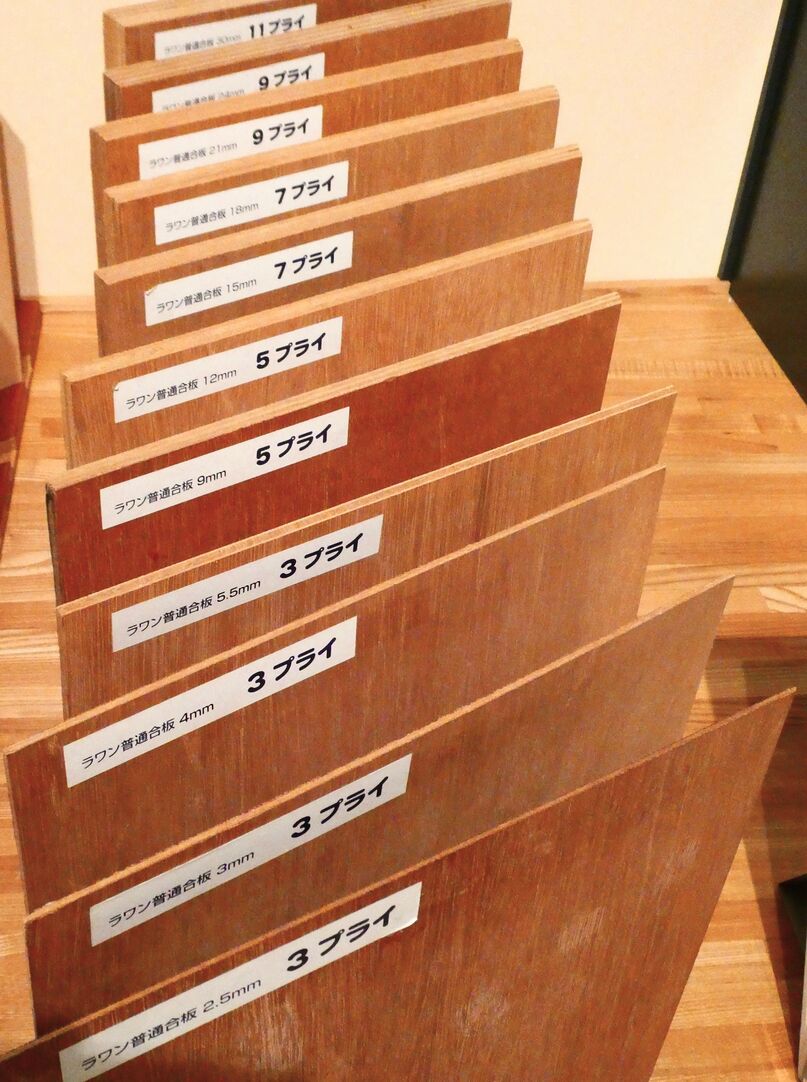ITTO releases latest report on world timber situation, showing surge in furniture exports
28 September 2023

Samples of lauan plywood at the Wood and Plywood Museum in Tokyo. Photo: Jean-Christophe Claudon/ITTO
28 September 2023: A major new analysis of global timber sector trends has found that exports by ITTO producer countries of secondary processed wood products have soared, reaching a value of USD 36.5 billion in 2022, up by nearly 40% compared with 2020 (USD 26 billion). A large part of this trade (USD 12 billion) comprised wooden furniture exported from Viet Nam to the United States of America.
ITTO's Biennial Review and Assessment of the World Timber Situation 2021–2022 is the latest in a long line of ITTO analyses of the production, trade and prices of primary wood products (industrial roundwood, sawnwood, veneer and plywood); trade and prices for secondary processed wood products; major traded tropical wood species; and directions of trade for primary tropical wood products. Data from the Review are included in ITTO’s online statistical database, spanning 1990–2022, a formidable tool for analyzing the evolution of, and long-term trends in, the trade of tropical timber and primary tropical timber products, as well as important shifts in timber production and further processing.
Other major findings of the Review for 2021–2022 include the following:
- The trade in tropical wood products was more resilient in 2021 than had been anticipated in early 2020 at the start of the COVID-19 pandemic, particularly the trade in secondary processed wood products. Demand picked up in the second half of 2020 and in 2021, when China’s economy returned to growth and the consumption of tropical secondary processed wood products increased in the USA and other consumer markets.
- In 2022, however, the world economy, already weakened by the pandemic, was affected by several shocks: higher-than-expected inflation worldwide, particularly in the USA and major European economies, triggering tighter financial conditions and reducing consumption of wood-based products; a worse-than-anticipated slowdown in China, the major tropical wood market, reflecting COVID-19 outbreaks and lockdowns and the tightening of regulatory controls to limit property speculation; and the war in Ukraine, which caused severe commodity and energy price shocks and trade disruptions for tropical wood products in 2022.
- World tropical log exports increased slightly in 2021, to 12.0 million m3, after reaching their lowest volume (11.5 million m3) in ITTO’s records in 2020. There was a further increase in 2022, to 12.7 million m3; Papua New Guinea (the world’s major tropical-log exporter) accounted for most of the increase over the two years. The volume of the tropical log trade had been on a downward trend from a peak in 2014 (when it exceeded 22.8 million m3), largely reflecting a downturn in Chinese demand and the declining availability of tropical logs, particularly in Southeast Asia. Malaysia’s log exports dropped by 34%, year-on-year, in 2021 and by 50% in 2022, to 305 000 m3; this was Malaysia’s lowest volume in ITTO’s statistical records.
- The trade in tropical sawnwood, plywood and veneer was relatively resilient in 2021–2022, responding to sharp recoveries in final-product consumer markets, particularly in the USA.
- China was the major tropical log importer in 2021 and 2022, but its imports have contracted by 44% (by volume) compared with the peak year of 2014. In 2021, China’s tropical log imports were affected by a tightening of regulatory controls to limit property speculation and cool the housing market and by disruptions to supply chains caused by soaring freight rates and shortages of shipping transport. Although the country’s tropical log imports increased in the first half of 2022, sporadic COVID-19 outbreaks and subsequent lockdowns disrupted supply chains later in the year, affecting wood processing and consumer spending. Importantly, in addition to a contraction in export demand for China’s processed wood products, the crisis in China’s real estate sector also constrained overall construction activity and reduced timber demand.
- The USA is now the major destination for tropical plywood—its imports grew substantially between 2017 and 2021, driven by an increase in repairs and remodelling during the pandemic and by surging economic growth in housing starts in 2021. The USA’s tropical plywood import volume dropped from 2.6 million m3 in 2021 to 1.8 million m3 in 2022, however, and is expected to also be constrained in 2023 by rising mortgage interest rates and affordability pressures on housing demand. Viet Nam’s plywood exports have surged from a low base; it is now the second-largest exporter of tropical plywood after Indonesia, while Malaysia’s exports have declined. Japan was once the world’s largest importer of tropical plywood, but its imports of this product fell sharply between 2013 and 2020, reaching a low of 1.555 million m3 in 2020. The country’s imports of tropical plywood rebounded slightly in 2021, to 1.739 million m3, but fell slightly again in 2022, to just over 1.656 million m3.
- ITTO producer country exports of secondary processed wood products (USD 36.5 billion) were three times higher in 2022 than their exports of tropical primary products (USD 12.1 billion). The major importers of secondary processed wood products from tropical countries are the USA, European Union countries (Germany, France and the Netherlands), the United Kingdom, Japan and Australia.

